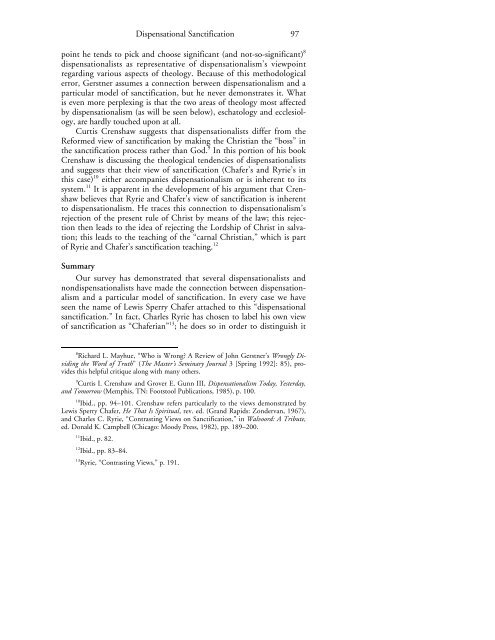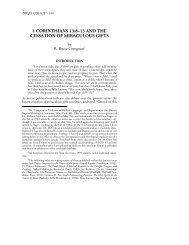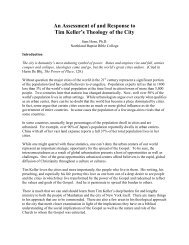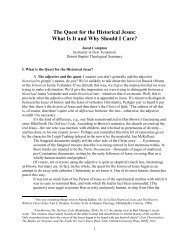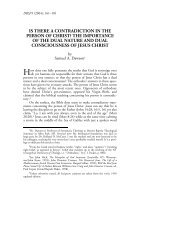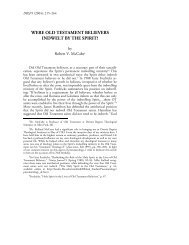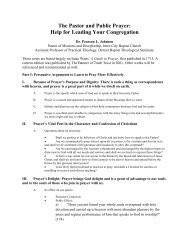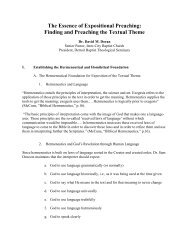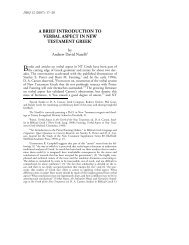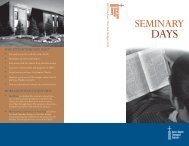Dispensational Sanctification: A Misnomer - Detroit Baptist ...
Dispensational Sanctification: A Misnomer - Detroit Baptist ...
Dispensational Sanctification: A Misnomer - Detroit Baptist ...
Create successful ePaper yourself
Turn your PDF publications into a flip-book with our unique Google optimized e-Paper software.
<strong>Dispensational</strong> <strong>Sanctification</strong> 97<br />
point he tends to pick and choose significant (and not-so-significant) 8<br />
dispensationalists as representative of dispensationalism’s viewpoint<br />
regarding various aspects of theology. Because of this methodological<br />
error, Gerstner assumes a connection between dispensationalism and a<br />
particular model of sanctification, but he never demonstrates it. What<br />
is even more perplexing is that the two areas of theology most affected<br />
by dispensationalism (as will be seen below), eschatology and ecclesiology,<br />
are hardly touched upon at all.<br />
Curtis Crenshaw suggests that dispensationalists differ from the<br />
Reformed view of sanctification by making the Christian the “boss” in<br />
the sanctification process rather than God. 9 In this portion of his book<br />
Crenshaw is discussing the theological tendencies of dispensationalists<br />
and suggests that their view of sanctification (Chafer’s and Ryrie’s in<br />
this case) 10 either accompanies dispensationalism or is inherent to its<br />
system. 11 It is apparent in the development of his argument that Crenshaw<br />
believes that Ryrie and Chafer’s view of sanctification is inherent<br />
to dispensationalism. He traces this connection to dispensationalism’s<br />
rejection of the present rule of Christ by means of the law; this rejection<br />
then leads to the idea of rejecting the Lordship of Christ in salvation;<br />
this leads to the teaching of the “carnal Christian,” which is part<br />
of Ryrie and Chafer’s sanctification teaching. 12<br />
Summary<br />
Our survey has demonstrated that several dispensationalists and<br />
nondispensationalists have made the connection between dispensationalism<br />
and a particular model of sanctification. In every case we have<br />
seen the name of Lewis Sperry Chafer attached to this “dispensational<br />
sanctification.” In fact, Charles Ryrie has chosen to label his own view<br />
of sanctification as “Chaferian” 13 ; he does so in order to distinguish it<br />
8<br />
Richard L. Mayhue, “Who is Wrong A Review of John Gerstner’s Wrongly Dividing<br />
the Word of Truth” (The Master’s Seminary Journal 3 [Spring 1992]: 85), provides<br />
this helpful critique along with many others.<br />
9<br />
Curtis I. Crenshaw and Grover E. Gunn III, <strong>Dispensational</strong>ism Today, Yesterday,<br />
and Tomorrow (Memphis, TN: Footstool Publications, 1985), p. 100.<br />
10<br />
Ibid., pp. 94–101. Crenshaw refers particularly to the views demonstrated by<br />
Lewis Sperry Chafer, He That Is Spiritual, rev. ed. (Grand Rapids: Zondervan, 1967),<br />
and Charles C. Ryrie, “Contrasting Views on <strong>Sanctification</strong>,” in Walvoord: A Tribute,<br />
ed. Donald K. Campbell (Chicago: Moody Press, 1982), pp. 189–200.<br />
11 Ibid., p. 82.<br />
12 Ibid., pp. 83–84.<br />
13 Ryrie, “Contrasting Views,” p. 191.


